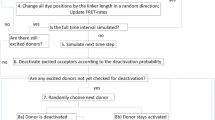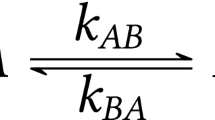Abstract
In this chapter we consider the decay of an optically excited state of a donor molecule in a fluctuating medium. The fluctuations are modeled by time dependent decay rates for electron transfer and its backreaction, deactivation by fluorescence or radiationless transitions and charge recombination to the groundstate . First we discuss a simple dichotomous model where the fluctuations of the rates are modeled by a random process switching between two values representing two different configurations of the environment. We solve the master equation and discuss the limits of fast and slow solvent fluctuations. In the second part, we apply continuous time random walk processes to model the diffusive motion. For an uncorrelated Markovian process, the coupled equations are solved with the help of the Laplace transformation. The results are generalized to describe the powertime law as observed for CO rebinding in myoglobin at low temperatures.
Access provided by CONRICYT-eBooks. Download chapter PDF
Similar content being viewed by others
In this chapter we consider the decay of an optically excited state of a donor molecule in a fluctuating medium. The fluctuations are modelled by time-dependent decay rates k (electron transfer), \(k_{-1}\) (backreaction), \(k_{da}\) (deactivation by fluorescence or radiationless transitions) and \(k_{cr}\) (charge recombination to the groundstate) (Fig. 9.1).
The time evolution is described by the system of rate equations
which has to be combined with suitable equations describing the dynamics of the environment. First we discuss a simple dichotomous model [32] where the fluctuations of the rates are modeled by a random process switching between two values representing two different configurations of the environment. We solve the master equation and discuss the limits of fast and slow solvent fluctuations. In the second part, we apply continuous time random walk processes to model the diffusive motion. For an uncorrelated Markovian process, the coupled equations are solved with the help of the Laplace transformation. The results are generalized to describe the powertime law as observed for CO rebinding in myoglobin at low temperatures.
1 Dichotomous Model
The fluctuations of the rates are modeled by random jumps between two different configurations (±) of the environment which modulates the values of the rates. The probabilities of the two states are determined by the master equation
which has the general solution
Obviously the equilibrium values are
and the correlation function is (with \(Q_{\pm }=\pm 1\))
Combination of the two systems of equations (9.1, 9.2) gives the equation of motion
for the four-component state vector
with the rate matrix
Generally, the solution of this equation can be expressed by using the left- and right eigenvectors and the eigenvalues \(\lambda \) of the rate matrix which obey
For the initial values \(\mathbf {W}(0)\) the solution is given byFootnote 1
In the following we consider a simplified case of gated transfer with \(k_{da}=k_{cr}=k_{-1}^{\pm }=k^{-}=0\) (Fig. 9.2). Then the rate matrix becomes
As initial values we chose
There is one eigenvalue \(\lambda _{1}=0\) corresponding to the eigenvectors
This reflects simply conservation of \(\sum _{\nu =1}^{4}W_{\nu }\) in this special case. The contribution of the zero eigenvector is
A second eigenvalue \(\lambda _{2}=-(\alpha +\beta )\) corresponds to the equilibrium in the final state \(D^{+}A^{-}\) where no further reactions take place
The contribution of this eigenvalue is
since we assumed equilibrium in the initial state. The remaining two eigenvalues are
and the resulting decay will be in general biexponential. We consider two limits:
1.1 Fast Solvent Fluctuations
In the limit of small k we expand the square root to find
One of the eigenvalues is
In the limit of \(k\rightarrow 0\) the corresponding eigenvectors are
and will not contribute significantly. The second eigenvalue
is given by the average rate. The eigenvectors are
and the contribution to the dynamics is
The total time dependence is approximately given by
1.2 Slow Solvent Fluctuations
In the opposite limit we expand the square root for small \(k^{-1}\) to find
and the time evolution is approximately
This corresponds to an inhomogeneous situation. One part of the ensemble is in a favorable environment and decays with the fast rate k. The rest has to wait for a suitable fluctuation which appears with a rate of \(\beta \).
1.3 Numerical Example
Figure 9.3 shows the transition from fast to slow solvent fluctuations.
Nonexponential decay. Numerical solutions of (9.12) are shown for \(\alpha =0.1, \beta =0.9\), (a) \(k=0.2\), (b) \(k=2\), (c) \(k=5\), (d) \(k=10\). Dotted curves show the two components of the initial state, solid curves show the total occupation of the initial state
2 Continuous Time Random Walk Processes
Diffusive motion can be modeled by random walk processes along a one dimensional coordinate.
2.1 Formulation of the Model
The fluctuations of the coordinate X(t) are described as random jumps [33, 34]. The time intervals between the jumps (waiting time ) and the coordinate changes are random variables with independent distribution functions
The probability that no jump happened in the interval \(0\cdots t\) is given by the survival function
and the probability of finding the walker at position X at time t is given by (Fig. 9.4)
Two limiting cases are well known from the theory of collisions. The correlated process with
corresponds to weak collisions. It includes normal diffusion processes as a special case. For instance if we chose
and
we have
and in the limit \(\varDelta t\rightarrow 0\), \(\varDelta X\rightarrow 0\) Taylor expansion gives
The leading terms constitute a diffusion equation
with drift velocity \((q-p)\frac{\varDelta X}{\varDelta t}\) and diffusion constant \(\frac{\varDelta X^{2}}{\varDelta t}\).
The uncorrelated process, on the other hand with
corresponds to strong collisions. This kind of process can be analyzed analytically and will be applied in the following.
The (normalized) stationary distribution \(\varPhi _{eq}\) of the uncorrelated process obeys
which shows that
2.2 Exponential Waiting Time Distribution
Consider an exponential distribution of waiting times
It can be obtained from a Poisson process which corresponds to the master equation
with the solution
if we identify the survival function with the probability to be in the initial state \(P_{0}\)
The general uncorrelated process (9.34) becomes for an exponential distribution
Laplace transformation gives
which can be simplified
Back transformation gives
and finally
which is obviously a Markovian process, since it involves only the time t. For the special case of an uncorrelated process with exponential waiting time distribution, the motion can be described by
2.3 Coupled Equations
Coupling of motion along the coordinate X with the reactions gives the following system of equations [35, 36]
where \(P(X, t)\varDelta X\) and \(C(X, t)\varDelta X\) are the probabilities of finding the system in the electronic state \(D^{*}\) or \(D^{+}A^{-}\), respectively, \(\mathcal {L}_{1,2}\) are operators describing the motion in the two states and the rates \(\tau _{1,2}^{-1}\) account for depopulation via additional channels. For the uncorrelated Markovian process (9.54) the rate equations take the form
which can be written in matrix notation as
Substitution
gives
Integration gives
and the total populations obey the integral equation
which can be solved with the help of a Laplace transformation
The Laplace transformed integral equation
is solved by
We assume that initially the system is in the initial state D* and the motion is equilibrated
For simplicity, we treat here only the case of \(\tau _{12}\rightarrow \infty \). Then we have
and with the abbreviations
and
we find
as well as
and the final result becomes
Let us discuss the special case of thermally activated electron transfer. Here
and the decay of the initial state is approximately given by
with
This can be visualized as the result of a simplified kinetic scheme
with the Laplace transform
which has the solution
In the time domain we find
Let us now consider the special case that the back reaction is negligible and \(k(X)=k\Theta (X)\) (Fig. 9.5). Here, we have
Inverse Laplace transformation gives a biexponential behaviour
with
If the fluctuations are slow \(\tau ^{-1}\ll k\) then
and the two time constants are approximately
3 Powertime Law Kinetics
The last example can be generalized to describe the powertime law as observed for CO rebinding in myoglobin at low temperatures. The protein motion is now modeled by a more general uncorrelated process.Footnote 2
We assume that the rate k is negligible for \(X<0\) and very large for \(X>0\). Consequently only jumps \(X<0\rightarrow X>0\) are considered. Then the probability obeys the equation
and the total occupation of inactive configurations is
Laplace transformation gives
with
and the decay of the initial state is given by
For a simple Poisson process (9.44) with
this gives
which reproduces the exponential decay found earlier in the slow solvent limit (9.95)
The long time behaviour is given by the asymptotic behavior for \(s\rightarrow 0\). As \(P_{<}(t)\rightarrow 0\) for \(t\rightarrow \infty \) this is also the case for \(\tilde{P}_{<}(s)\) in the limit \(s\rightarrow 0\). Hence the asymptotic behaviour must be
In order to describe a powertime law at long times
the waiting time distribution has to be chosen as
which implies
where \(z^{-1}\) is the characteristic time for reaching the asymptotics. Finally, we find
In the time domain this corresponds to the Mittag–Leffler functionFootnote 3
which can be approximated by the simpler function
Notes
- 1.
In the case of degenerate eigenvalues, linear combinations of the corresponding vectors can be found such that \(\mathbf {L}_{\nu }\bullet \mathbf {L}_{\nu '}=0 \text{ for } \nu \ne \nu '\).
- 2.
A much more detailed discussion is given in: [36].
- 3.
Which has also been discussed for nonexponential relaxation in inelastic solids and dipole relaxation processes corresponding to Cole-Cole spectra.
Author information
Authors and Affiliations
Corresponding author
Problems
Problems
9.1
Dichotomous Model for Dispersive Kinetics

Consider the following system of rate equations
Determine the eigenvalues of the rate matrix M. Calculate the left- and right eigenvectors approximately for the two limiting cases:
(a) fast fluctuations \(k_{\pm }\ll \alpha ,\beta \). Show that the initial state decays with an average rate.
(b) slow fluctuations \(k_{\pm }\gg \alpha ,\beta \). Show that the decay is nonexponential.
Rights and permissions
Copyright information
© 2017 Springer-Verlag GmbH Germany
About this chapter
Cite this chapter
Scherer, P.O.J., Fischer, S.F. (2017). Dispersive Kinetics. In: Theoretical Molecular Biophysics. Biological and Medical Physics, Biomedical Engineering. Springer, Berlin, Heidelberg. https://doi.org/10.1007/978-3-662-55671-9_9
Download citation
DOI: https://doi.org/10.1007/978-3-662-55671-9_9
Published:
Publisher Name: Springer, Berlin, Heidelberg
Print ISBN: 978-3-662-55670-2
Online ISBN: 978-3-662-55671-9
eBook Packages: Physics and AstronomyPhysics and Astronomy (R0)









